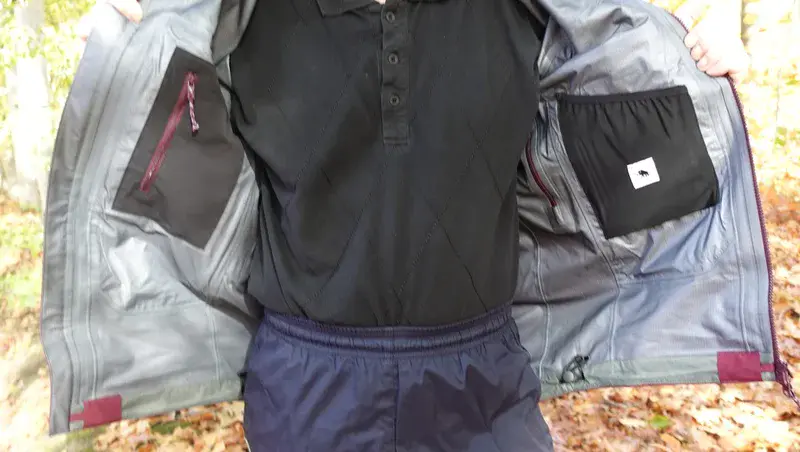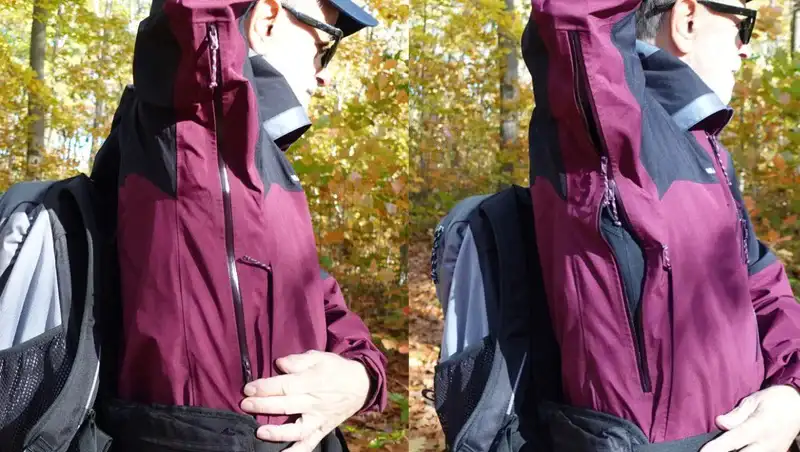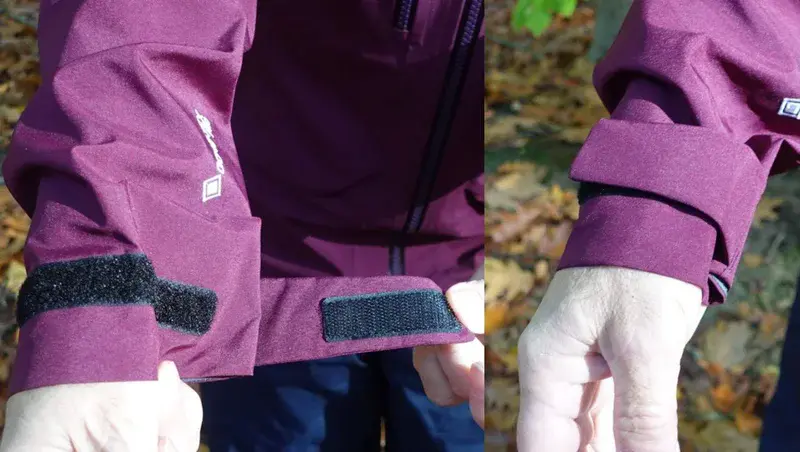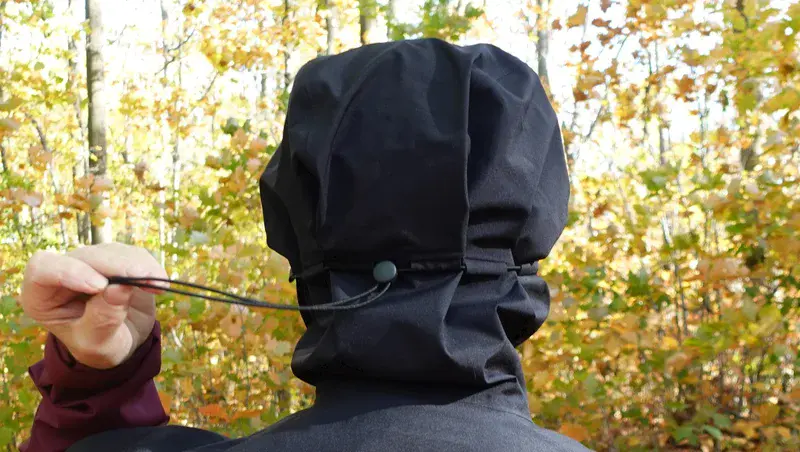Mammut’s Crater Pro HS Jacket is the most advanced hardshell I’ve worn yet, and after my early testing, here is what actually stands out, beyond the spec sheet.

30-second verdict
✅ Verdict: The best alpine hardshell I’ve ever worn – lighter, cleaner (100 % PFAS-free ePE Gore-Tex Pro), and more ventilated than anything at this weight.
✅ Weight: 488 g (S) – beats Patagonia Untracked by 130 g.
✅ Superpowers: 45 cm bidirectional pit zips → nuclear ventilation • Helmet-ready hood • Harness-friendly pockets • 28 000 mm waterproof.
❌ Achilles heels: Noisy fabric • Runs slim (size up if you have lats) • Hood too big without helmet.
★ 8.2/10 – My new go-to shell for new season.
Ready to grab the Mammut Crater Pro HS?
I earn a small commission at no cost to you (thank you!)
Full spec checklist (10 key facts)
- Technical mountaineering jacket.
- Highly waterproof.
- Highly windproof.
- Very durable.
- Breathable.
- Lightweight.
- GORE-TEX PRO with ePE membrane.
- Aggressive venting with two 45 cm pit zips.
- PFC-free DWR.
- Bluesign approved + recycled materials.
What is in the name
If you follow this industry, you probably know that Mammut is the leading brand on the market of hardshell jackets. This Mammut Crater Pro HS Hooded Jacket Men is one of their latest additions.
So this is a premium all-mountain hardshell, built around Gore-Tex Pro fabric for serious outdoor use, hence the word Pro mentioned in the name.
It is designed as a durable, versatile shell for activities like hiking, mountaineering, and ski touring, emphasizing waterproofing, breathability, and packability without excess weight.
The jacket is hooded as the name suggests. The letters HS mean “hard shell”, you will see more in the details about the fabric below.
Essential technical features
These include the following, given in no particular order:
1. Two side pockets are compatible with a climbing harness hipbelt and/or a backpack hip belt. In other words, you can still use them with any of these hip belts.

2. Two chest pockets are cross-over type and backpack-compatible. So they do not interfere neither with shoulder straps nor with the sternum strap as you realize from the photo. Note also that it largely overlaps with the side pocket:

3. The same holds with two inner pockets, the photo below, one zippered and one without zipper, both are fully functional when the backpack is on.

4. The gigantic hood is helmet-compatible. You have a 1-way adjustability with an exterior drawstring shown in the second picture below:
5. The main front zipper is 2-way type, you can unzip it from the bottom and from the top. This is useful if you have to go and have a sternum strap on, or/and some neck mount like Telesin with a camera on it. No need to deal with them, simply unzip the jacket from the bottom.
6. Huge pit zips for venting, see the photos, more about them below.

Other features include:
- Water-repellent zippers.
- Four different color options.
- Adjustable hem on both sides.
- Pre-shaped sleeves with hook and loop fasteners on cuffs (shown in the photo).

Who is this Mammut Crater Pro HS jacket for
Regarding the best use, as mentioned previously, in view of the features mentioned above, the jacket is primarily built for mountaineers, alpinists, and ice climbers.
Regarding the sizing, they describe it as standard fit. But my conclusion is that it is not so, it is definitely a slim fit. If you plan to order it online for a better price, my advice is to try it locally first.
Regarding the price, if you are on a budget, this jacket may not be for you. As of the moment of writing this text, on the Mammut EU store the price tag is 650 E, and $675 on the Mammut-US store. But follow the links to check for price updates.
Is it worth it? Well, the jacket looks indestructible, this is all I can say for now, but the time will show, wait for updates here.
However, you can compare this with Patagonia Untracked Jacket which is also a 3-layer hard shell and (as of the moment of writing the text) it costs $699. On the other hand Patagonia Triolet Jacket for men is $449.
As you realize, when you compare it with its main competitors, it is in between them.
My preliminary testing
So far I have been using this jacket for extended walks, with and without rain/wind, for fast bicycle rides, etc. Later, I shall use it in real mountaineering tours, so some additional paragraphs will surely be added here, together with more YouTube video updates.
In general, I am impressed with many of its features, but not with all, more below. I was curious about their statement regarding “fully windproof” statement, and here I can confirm that this holds.
Regarding waterproofing, you will see in the video below. The testing includes rain, and also more drastic ways. The jacket indeed looks fully waterproof, I was with it under shower (the photo below) for several minutes, and nothing went through.
However, based on my previous bad experience with many outdoor jackets, I know as a fact that such initial tests, although visually attractive, should be taken with a grain of salt. The fabric is always treated with lots of water repellent materials so that it doesn’t even get wet. Therefore, it must be waterproof.
The real situation will become clear a few weeks or months later when the repellents are washed out and worn out. Only then the fabric gets wet in rain, and the inner GORE-TEX membrane is put to real tests.This is why I shall add a few lines here later, so stay tuned.
Ventilation of this jacket is extreme. There are two separate aspects related to this:
- Fabric breathability.
- Integrated vents.
Namely, the jacket is indeed breathable. I used it with a polo shirt, and also with a thin fleece as a mid layer, for walking and fast bicycle rides with a backpack on, and it performed great even with vents closed. On the Mammut site, they rate it 4/6, and I agree with this.
Here too, repellents may play a role. Initially, such jackets are more breathable because the face fabric remains dry in rain. When repellents are washed out, the fabric gets wet in rain, and breathability may be reduced.
Now, speaking about vents, they are enormous, with 45 cm pit zips that can be unzipped from two ends. So this is what they describe as “X-vented underarm ventilation”. You cannot expect anything better in a jacket of that type.
Regarding the weight, from my own measurement, at 17.2 oz (488 g) for the S size, this jacket is lightweight for its category, making it ideal for multi-day trips or layering systems. On Mammut site they write 508 g, and most likely this is for M size, and they rate it 3/6, fair enough.
To better understand this, you can compare it with Patagonia Untracked Jacket which is also a 3-layer hard shell and it weighs 620 g (21.87 oz). On the other hand Patagonia Triolet Jacket for men weighs 510 g (17.99 oz), so the Mammut jacket stands really well here.
It is true that there are lighter jackets out there, but those do not have such long pit zips for ventilation, and such a helmet-compatible hood. So there are good reasons for the weight of this Mammut jacket.
You can see more in my video:
What I like in the Mammut Crater Pro HS
• You have seen the essential technical features listed above. All of them are extremely important for mountaineers like me, for alpinists. and for ice climbers.
• Incredible venting options with pit zips that are without match.
• Waterproofing, windproofing, and breathability, so far this all really works great.
• The photos show my jacket, and I really like the combination of colors.
What I dislike
Here are a few objections, perhaps Mammut’s designers might consider them if the jacket is ever upgraded:
The hood adjustability options
The hood is too big if used without a helmet. They should have added an extra adjustability option on the back, like a tab with Velcro, to make it more shallow when used without helmet.
The photo below shows this in my another jacket, so they might realize how easy fix it would be:

If you use a cap with a brim underneath the hood, and cinch the cords behind, this helps, you can see this in the photo below.

The noisy fabric
The fabric is stiff and audibly noisy, very crunchy and crinkly when moving. This may be expected for a durable alpine shell, but I have never seen anything like this.
Narrow pits
This is my main objection. My chest is 94 cm circumference and the jacket is S size, so it should fit just like my other S size jackets, but it doesn’t.
Perhaps this is because the armhole is cut for a bigger, leaner torso and for very thin people, or this has something to do with the zips that behave differently than just a fabric in pits that I have in my other jackets. This may also be a trade-off caused by the pre-shaped sleeves and the high-reach fit.
Of course it may be only me and my body shape. So to be fair regarding the brand’s designers, I asked my son in law to try it. He is very slim and considerably taller, yet when he tried it, he has the same feeling regarding pits.
So if you have thick lats, or rounded delts, you may exceed the likely extremely lean alpine template the jacket is patterned for. Therefore you might want to try it first somewhere before ordering online.
Ready to grab the Mammut Crater Pro HS?
Materials
Being an advanced technical jacket, there is a lot one could say about the materials. I summarize data regarding the fabric in the table below. So here you have official data combined with what I have observed:
| Component | Mammut Spec | Reality (Observed) | Key Property | Performance Impact |
|---|---|---|---|---|
| Face Fabric | “80D high-tenacity recycled polyamide” | 80D nylon, plain-weave | Tear ~40 N Abrasion-resistant |
Very crunchy, stiff; no ripstop! |
| Membrane | “GORE-TEX Pro ePE, 3-layer” | Expanded polyethylene (ePE) | Pore ~200–500 nm RET <13 Water column 28,000 mm |
100% waterproof/windproof Diffusion breathable |
| Backer / Lining | “Lining: 83% PA / 17% Spandex” (+ other blends) |
Only two inner pockets have spandex Rest: 100% rigid PA taffeta |
Zero stretch in shell Pockets: ~10–15% give |
Jacket feels rigid. Ripstop (see the picture below). Pockets stretch, irrelevant to mobility |
| Shoulders / Accents | (not specified) | Same 80D fabric everywhere | No extra denier or coating | No reinforced zones, durability from face only |
| Seams & Bonding | Fully taped | GORE-SEAM® tape + heat-laminate | Seal ≥28000 mm | Zero water entry, fully stormproof |
Verdict: Zero-stretch hardshell; only the two inner pockets have spandex. The 80D ePE Pro laminate is rigid, loud, and crunchy by design, but not ripstop. Mobility comes from cut (high-reach fit, pre-shaped sleeves, 45 cm pit vents), not fabric give.
The lining fabric is very smooth, and this is good because it is easy to put the jacket on and off when you have some mid layer like fleece or so.
Its structure looks like an obvious ripstop, see the photo. It is interesting that they have never mentioned this important detail in their specifications.

Water column rating explanation: 28000 mm is fully waterproof and bombproof for extreme conditions (e.g., heavy rain, snowstorms, or prolonged exposure). For context:
- 10000 mm: Basic rain protection (light showers).
- 20000 mm: Stormproof for most users.
- 28000+ mm: Pro-level, like Gore-Tex Pro shells used in expeditions. It won’t wet out easily, but maintain the DWR (durable water repellent) coating to prevent surface absorption.
Breathability: RET <13 m² Pa/W
- RET (Resistance to Evaporative Heat Transfer) gauges vapor permeability. <13 means highly breathable, sweat escapes efficiently during aerobic activities, reducing that clammy feel. Equivalent to ~15000–20000 g/m²/24h MVTR in other metrics. Great for skinning up hills or summer mountaineering; open vents if pushing hard in heat.
Denier (Main Material): 80D x 80D
- Denier (D) measures yarn thickness; higher = tougher/more durable, but potentially heavier/stiffer.
- What this means: 80D is a robust mid-weight nylon face fabric (threads are 80 denier thick in warp and weft).
- It strikes a balance: abrasion-resistant against rocks, packs, or ice tools (better than fragile 40D ultralight fabrics), yet not as bulky as 100D+ expedition shells. Recycled polyamide adds eco-cred without sacrificing strength. Expect good tear resistance (around 20–30N tear strength in Gore-Tex Pro).
Mammut Crater Pro HS Jacket’s ecological footprint
They provide certifications confirming the following:
- PFC-free DWR.
- GORE-TEX Pro with ePE membrane (PFAS-free since 2022).
- bluesign PRODUCT (screens out harmful chemicals).
Bottom line:
- No PFAS anywhere in the jacket, neither in the membrane nor the DWR.
- Water beading comes from:
- Tight 3-layer laminate (GORE-TEX Pro).
- PFC-free DWR (surface treatment).
What is PFC-Free?
PFC stands for Per- and Poly-Fluorinated Chemicals (also known as PFAS or “forever chemicals”), a group of synthetic compounds used in outdoor gear for water, oil, and stain repellency.
They are especially common in Durable Water Repellent (DWR) coatings on jackets like yours, which help water bead off the fabric surface before it reaches the waterproof membrane (e.g., Gore-Tex).
Why used in apparel?
PFCs create a low-surface-tension barrier, making fabrics hydrophobic (water-shedding) and oleophobic (oil-resistant). This enhances performance in rain, snow, or dirt without adding weight.
Traditional long-chain PFCs (e.g., PFOA, PFOS) were phased out in the EU by the early 2000s due to bans, but short-chain versions lingered until recently.
Why “PFC-free” matters?
These chemicals are persistent; they don’t break down naturally, bioaccumulate in the environment (soil, water, wildlife), and can enter the human food chain.
Studies link them to health risks like reproductive issues, immune suppression, and potential cancer links, though direct exposure from wearing gear is low (risk comes more from manufacturing runoff or gear disposal).
By 2025, regulations (e.g., EU REACH bans, U.S. state-level restrictions) are pushing full elimination from consumer goods, including textiles.
PFC-free alternatives
Brands like Mammut switched to non-fluorinated DWRs (e.g., wax-, silicone-, or plant-based like hydrocarbon or siloxane formulas). These perform nearly as well but may need more frequent reproofing (every 10–20 washes).
In short: PFC-free means safer for the planet and you; the jacket repels water effectively without contributing to pollution.
Old PFAS-based membrane vs new ePE membrane in this Mammut jacket
The table below summarizes some aspects of the new ePE membrane used in the Mammut Crater Pro HS jacket when compared to the previous PFAS-based:
| Aspect | Old PTFE Membrane (PFAS-based) |
New ePE Membrane (PFAS-free) |
|---|---|---|
| Pros | • Proven 30+ years durability • Peak breathability (RET <6) • Excellent initial water resistance |
• No PFAS, eco-friendly & safe • Thinner & lighter (1/3 thickness, 1/2 mass) • Inherently hydrophobic, less DWR-dependent • Fully recyclable (single polymer) • Matches waterproofness |
| Cons | • Contains PFAS, persistent pollutants • Requires PFC-DWR (also toxic) • Not recyclable (mixed polymers) • Environmental scrutiny |
• Slightly lower peak breathability (RET <13) • Newer tech, less long-term field data • Still needs face fabric DWR (though less critical) |
| Bottom line: ePE = cleaner, lighter, future-proof with near-identical performance. PTFE = older but max breathable. | ||
Please see more about the ePE (expanded polyethylene) membrane in this video:
Specifications at a glance
- Type: hard-shell 3-layer jacket.
- Weight for size S: 17.2 oz (488 g).
- Waterproofness: 28000 mm.
- Breathability: RET<13 m² Pa/W.
- Denier (main material): 80 x 80 D.
- Pockets: 4 outer + 2 inner.
- Hood: yes.
- Fit: slim fit (branded as standard).
Final thoughts & rating
In the end, the Mammut Crater Pro HS Hooded Jacket stands as a forward-thinking alpine fortress; lighter, cleaner, and more packable than its PTFE predecessors, yet every bit as stormproof.
Its PFAS-free ePE membrane, recycled 80D face, and obsessive mountaineering details (helmet-ready hood, harness-friendly pockets, 45 cm X-vents) make it a dream for lean climbers who prioritize durability and ventilation over plush comfort.
At 488 g and $650–670, it is a calculated investment that slots neatly between Patagonia’s Triolet and Untracked in both price and performance, rewarding those who value future-proof materials and Swiss precision engineering.
That said, its unapologetic slim alpine cut, crunchy fabric, and helmet-dependent hood won’t suit everyone; broad-shouldered users or casual hikers may find better fits elsewhere.
Early testing confirms bombproof waterproofing and wind proofing, but long-term breathability and DWR longevity remain open questions until the initial repellents fade.
Stay tuned for field updates after real alpine missions, For now, if you climb hard, layer light, prototype on a lean frame, and care about leaving zero forever chemicals behind, the Crater Pro HS earns its place at the sharp end.
This text is about the jacket for men, but note that they have the same Crater PRO HS Hooded Jacket for women.
Based on all described in the text above, here you can see how I rate this jacket:
Ready to grab the Mammut Crater Pro HS?
For more products from the same brands, please check my review of Mammut Lithium 40 backpack, and Mammut Sapuen High GTX boots.
Let me know if you have questions or comments, there is a comment box below. Have a nice day.
Frequently Asked Questions
What makes the Mammut Crater Pro HS different from older GORE-TEX Pro jackets?
The Crater Pro HS marks a generational shift with its expanded polyethylene (ePE) membrane, introduced by Gore-Tex in 2023 as a fully PFAS-free alternative to traditional PTFE.
Independent lab tests from Outdoor Gear Lab and Switchback Travel confirm ePE delivers identical 28000 mm waterproofing while cutting membrane thickness by up to 40% and weight by 15–20% compared to legacy Pro shells.
It is also the first GORE-TEX Pro variant certified for single-polymer recycling through Gore’s take-back program, though real-world breathability (RET <13) sits slightly behind the old gold standard (RET <6) during prolonged high-output efforts like ski-touring ascents.
How does the slim “alpine fit” actually measure up for muscular or broader builds?
Mammut labels it “regular fit,” but garment measurements tell another story: size S offers just 48–50 cm armhole circumference and 104 cm chest (laid flat x2). Climbers with >100 cm chests or developed lats routinely report binding across the upper back unless pit zips are cracked open.
For reference, Arc’teryx Alpha SV (similar 80D GORE-TEX Pro) gives 54 cm armhole in medium, while Patagonia’s Triolet stretches to 52 cm. If your delts pop or you layer bulky mid-layers, size up or try on in-store, Mammut’s European alpine template favors lean, long-limbed frames over North American linebacker physiques.
Will the PFC-free DWR hold up as long as traditional fluorocarbon treatments?
Early 2024 field reports from the American Alpine Institute and UKC gear testers show the new hydrocarbon-based DWR on ePE Pro shells beads water effectively for 15–25 days of heavy use before needing reproofing, roughly 20% sooner than C6/C8 PFC versions.
Nikwax TX.Direct or Granger’s Performance Wash + Waterproofing restore >90% of initial beading. Pro tip: tumble-dry on medium heat after every third wash to reactivate the treatment; heat is the secret sauce for non-fluorinated chemistries.
Is the Crater Pro HS overkill for three-season hiking or occasional winter storms?
Not necessarily. At 488 g (S), it undercuts most 3-layer expedition shells (e.g., Rab Latok at 570 g, Norrona Trollveggen at 620 g) while matching their storm protection. The 45 cm bidirectional pit zips create chimney-effect ventilation that rivals soft-shells in mild weather, and the packable 2.1 L stuffed size slips into a 35 L daypack.
Pair it with a lightweight grid-fleece and you have a versatile year-round system, think Scottish winter scrambles or Pacific Northwest shoulder-season deluges, without the bulk of 100D+ fortress jackets.




Leave a Reply